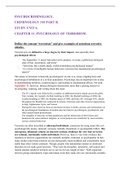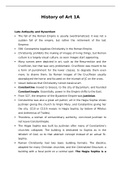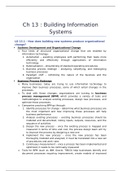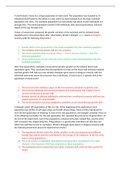PSYCHOCRIMINOLOGY.
CRIMINOLOGY 310 PART B.
STUDY UNIT 6.
CHAPTER 11: PSYCHOLOGY OF TERRORISM.
Define the concept “terrorism” and give examples of notorious terrorist
attacks.
Terrorist acts are defined to a large degree by their impact, and especially their
psychological effects
- “the September 11 attack had achieved its purpose: to create a global psychological
state of fear, uncertainty, and terror”
- “Terrorism, like a shark attack, wields tremendous psychological impact”
- “As a form of intelligible human behaviour, terrorism has fundamental psychological
aspects”
The nature of terrorism is basically psychological; its aim is to create crippling fears and
psychological debilitation in a civilian population. Psychology has an important role to play
in understanding terrorism, counteracting it, and treating its traumatizing effects. Not until
September 11, however, did psychologists demonstrate more than a passing interest in
investigating, studying, and writing about this topic.
- The 9/11 attacks were followed by a number of additional terrorist attacks across the globe.
They include, for example, the Bali bombing in 2002, the Madrid bombings of 2004, the
London bombing of 2005, the Mumbai attack of 2008, and from 2011 through 2015, attacks
throughout the Middle East conducted by Islamic extremists and other terrorist organizations
in Iraq, Afghanistan, Syria, and Yemen.
- During this time, there has been an enormous increase in books, articles, and commentary on
the psychological foundations of modern-day terrorism by psychologists, psychiatrists, and
other mental health professionals.
- The slaughter of innocent civilian populations and the destruction of their homes and
businesses for some political, religious, or social purpose are considered, by most societies,
serious criminal behaviour.
Terrorists are often described as abnormal individuals, sometimes by using terms like evil,
psychologically insane, immoral, seriously mentally disordered, or psychopathic killers. The
outrageous, inhumane attacks on innocent civilians challenge the view that terrorists
are rational, emotionally stable individuals. However, there is very little evidence that
members of terrorist organizations are mentally unstable, irrational, or psychopathic In fact,
many studies report that terrorists are psychologically much healthier and considerably more
stable than other violent criminals. Though, people who demonstrate mental or emotional
disorders do not make good terrorists. “They lack the discipline, rationality, self-control and
mental stamina needed if terrorists are to survive for any length of time”. Well-organized
terrorist groups immediately expel individuals from their ranks who are emotionally unstable,
,primarily because they represent a security threat. Much of the aggression displayed by
violent criminals is spontaneous or reactive; terrorist organizations go to great lengths
preparing for their attacks, and any breach of their plans seriously compromises their goals.
In summary, terrorism is most often a rational behaviour based on the belief that
violence is morally justified and necessary to further political goals. It is not rational
to non-terrorists, but it is rational to the person or group that embraces it.
The world is dealing with the emergence of the Islamic State of Iraq and the Levant
(ISIL). Many experts prefer to call the terrorist group ISIS, referring to the Islamic State of
Iraq and al-Sham.
o ISIS is a dangerous terrorist organization that has the ambitious goal to solidify and expand its
control of territory and govern by implementing its violent interpretation of sharia (Islamic)
law. The organization believes it requires territory to remain legitimate and follow caliphate
rule.
o The frightening terrorist message of ISIS is promoted by images of extreme violence and
brutality and the innovative use of social media, such as for recruitment purposes.
o However, ISIS and other radical-Islamic groups must not be equated with the practice of
Islam as a religion. Muslims across the world are peaceful people and do not support the
tactics of radical groups that perpetrate violence in their name.
o Misunderstanding of Islam—which is one of the world’s fastest-growing religions—is
demonstrated in a surge in hate crimes against Muslims.
o ISIS has strongly encouraged lone individuals or insular groups in the United States and other
Western countries to attack the authority figures and cultural events and symbols in their own
countries. These lone terrorist or insular groups that are directly or loosely tied to terrorist
organizations in other countries are often referred to as Homegrown Violent Extremists
(HVEs). Terrorist attacks by HVEs are quickly becoming the preferred strategy in modern
terrorism, often enabled by access to dark sites on the Internet. An example of an HVE attack
advocated by foreign terrorist organizations is the 2013 Boston Marathon bombings. The
plots devised by HVEs are difficult to identify beforehand because they often display few
behaviours that law enforcement and intelligence officers usually utilize to detect readiness to
commit violence. In some cases, those who carry out attacks have been on the radar of
government officials, but without sufficient evidence to question or detain them.
DEFINITIONS AND EXAMPLES:
Definition of terrorism =
- According to Sternberg (2003), terrorism is simply “the systematic use of terror,
especially as a means of coercion”.
- Hallett (2004) defines the term as a theatrical crime against person or property in
which only symbolic or psychological satisfaction to the perpetrators is gained.
- In federal law, terrorism is defined as “the unlawful use of force or violence against
persons or property to intimidate or coerce a government, the civilian population, or
any segment thereof, in furtherance of political or social objectives”
Under federal law, terrorism may be either domestic or international, depending on the
origin, base, and objectives of the terrorist organization
, Domestic terrorism refers to the actions of groups or an individual based and
operating entirely within the United States or Puerto Rico without clear foreign direction—
although there may be foreign influence.
- A well-known example is the Oklahoma City bombing on April 17, 1995, when a
truck bomb destroyed the Alfred P. Murrah Federal Building, killing 167 (19 were
children, most of whom were in a day care center on the premises) and injuring 684
persons.
- More recently, on November 5, 2009, Army Major Nidal Hasan killed 13 people and
wounded 32 others at Fort Hood, Texas.
- Other illustrations of domestic terrorism include actions by members of far-right
extremist groups, including political and religious white supremacists, such as Aryan
Nations and neo-Nazi organizations. For example, members of the so-called “Army of
God” claimed responsibility for the bombings of clinics that provide abortions and an
alternative lifestyle nightclub in Atlanta. This form of domestic terrorism is
increasingly gaining attention in the scholarly literature, and many law enforcement
authorities consider it a greater threat to national security than international terrorism.
International terrorism refers to violent acts or acts dangerous to human life that
are a violation of the criminal laws of the United States or any state and under the direction of
a foreign government, group, organization, or person.
- Although terrorist activities are widespread and affect people throughout the world,
the most vivid example of international terrorism and the one most covered by the
media and the research literature is that represented by the events that occurred on
September 11, 2001. With that exception, most international terrorism aimed at U.S.
property or citizens occurs in other countries.
- For example, in the late twentieth century, groups in Columbia targeted American
interests, kidnapped seven U.S. citizens, and carried out multiple bombings against oil
pipelines used by American companies.
- Counterterrorism Center (NCTC) on global attacks in 2008. Despite these sobering
numbers, Americans living or visiting abroad are no more likely to be victimized by
terrorist activities than are citizens of other nations.
- Terrorist activities were a fact of life in other parts of the world long before
September 11, and they have continued since then.
CRIMINOLOGY 310 PART B.
STUDY UNIT 6.
CHAPTER 11: PSYCHOLOGY OF TERRORISM.
Define the concept “terrorism” and give examples of notorious terrorist
attacks.
Terrorist acts are defined to a large degree by their impact, and especially their
psychological effects
- “the September 11 attack had achieved its purpose: to create a global psychological
state of fear, uncertainty, and terror”
- “Terrorism, like a shark attack, wields tremendous psychological impact”
- “As a form of intelligible human behaviour, terrorism has fundamental psychological
aspects”
The nature of terrorism is basically psychological; its aim is to create crippling fears and
psychological debilitation in a civilian population. Psychology has an important role to play
in understanding terrorism, counteracting it, and treating its traumatizing effects. Not until
September 11, however, did psychologists demonstrate more than a passing interest in
investigating, studying, and writing about this topic.
- The 9/11 attacks were followed by a number of additional terrorist attacks across the globe.
They include, for example, the Bali bombing in 2002, the Madrid bombings of 2004, the
London bombing of 2005, the Mumbai attack of 2008, and from 2011 through 2015, attacks
throughout the Middle East conducted by Islamic extremists and other terrorist organizations
in Iraq, Afghanistan, Syria, and Yemen.
- During this time, there has been an enormous increase in books, articles, and commentary on
the psychological foundations of modern-day terrorism by psychologists, psychiatrists, and
other mental health professionals.
- The slaughter of innocent civilian populations and the destruction of their homes and
businesses for some political, religious, or social purpose are considered, by most societies,
serious criminal behaviour.
Terrorists are often described as abnormal individuals, sometimes by using terms like evil,
psychologically insane, immoral, seriously mentally disordered, or psychopathic killers. The
outrageous, inhumane attacks on innocent civilians challenge the view that terrorists
are rational, emotionally stable individuals. However, there is very little evidence that
members of terrorist organizations are mentally unstable, irrational, or psychopathic In fact,
many studies report that terrorists are psychologically much healthier and considerably more
stable than other violent criminals. Though, people who demonstrate mental or emotional
disorders do not make good terrorists. “They lack the discipline, rationality, self-control and
mental stamina needed if terrorists are to survive for any length of time”. Well-organized
terrorist groups immediately expel individuals from their ranks who are emotionally unstable,
,primarily because they represent a security threat. Much of the aggression displayed by
violent criminals is spontaneous or reactive; terrorist organizations go to great lengths
preparing for their attacks, and any breach of their plans seriously compromises their goals.
In summary, terrorism is most often a rational behaviour based on the belief that
violence is morally justified and necessary to further political goals. It is not rational
to non-terrorists, but it is rational to the person or group that embraces it.
The world is dealing with the emergence of the Islamic State of Iraq and the Levant
(ISIL). Many experts prefer to call the terrorist group ISIS, referring to the Islamic State of
Iraq and al-Sham.
o ISIS is a dangerous terrorist organization that has the ambitious goal to solidify and expand its
control of territory and govern by implementing its violent interpretation of sharia (Islamic)
law. The organization believes it requires territory to remain legitimate and follow caliphate
rule.
o The frightening terrorist message of ISIS is promoted by images of extreme violence and
brutality and the innovative use of social media, such as for recruitment purposes.
o However, ISIS and other radical-Islamic groups must not be equated with the practice of
Islam as a religion. Muslims across the world are peaceful people and do not support the
tactics of radical groups that perpetrate violence in their name.
o Misunderstanding of Islam—which is one of the world’s fastest-growing religions—is
demonstrated in a surge in hate crimes against Muslims.
o ISIS has strongly encouraged lone individuals or insular groups in the United States and other
Western countries to attack the authority figures and cultural events and symbols in their own
countries. These lone terrorist or insular groups that are directly or loosely tied to terrorist
organizations in other countries are often referred to as Homegrown Violent Extremists
(HVEs). Terrorist attacks by HVEs are quickly becoming the preferred strategy in modern
terrorism, often enabled by access to dark sites on the Internet. An example of an HVE attack
advocated by foreign terrorist organizations is the 2013 Boston Marathon bombings. The
plots devised by HVEs are difficult to identify beforehand because they often display few
behaviours that law enforcement and intelligence officers usually utilize to detect readiness to
commit violence. In some cases, those who carry out attacks have been on the radar of
government officials, but without sufficient evidence to question or detain them.
DEFINITIONS AND EXAMPLES:
Definition of terrorism =
- According to Sternberg (2003), terrorism is simply “the systematic use of terror,
especially as a means of coercion”.
- Hallett (2004) defines the term as a theatrical crime against person or property in
which only symbolic or psychological satisfaction to the perpetrators is gained.
- In federal law, terrorism is defined as “the unlawful use of force or violence against
persons or property to intimidate or coerce a government, the civilian population, or
any segment thereof, in furtherance of political or social objectives”
Under federal law, terrorism may be either domestic or international, depending on the
origin, base, and objectives of the terrorist organization
, Domestic terrorism refers to the actions of groups or an individual based and
operating entirely within the United States or Puerto Rico without clear foreign direction—
although there may be foreign influence.
- A well-known example is the Oklahoma City bombing on April 17, 1995, when a
truck bomb destroyed the Alfred P. Murrah Federal Building, killing 167 (19 were
children, most of whom were in a day care center on the premises) and injuring 684
persons.
- More recently, on November 5, 2009, Army Major Nidal Hasan killed 13 people and
wounded 32 others at Fort Hood, Texas.
- Other illustrations of domestic terrorism include actions by members of far-right
extremist groups, including political and religious white supremacists, such as Aryan
Nations and neo-Nazi organizations. For example, members of the so-called “Army of
God” claimed responsibility for the bombings of clinics that provide abortions and an
alternative lifestyle nightclub in Atlanta. This form of domestic terrorism is
increasingly gaining attention in the scholarly literature, and many law enforcement
authorities consider it a greater threat to national security than international terrorism.
International terrorism refers to violent acts or acts dangerous to human life that
are a violation of the criminal laws of the United States or any state and under the direction of
a foreign government, group, organization, or person.
- Although terrorist activities are widespread and affect people throughout the world,
the most vivid example of international terrorism and the one most covered by the
media and the research literature is that represented by the events that occurred on
September 11, 2001. With that exception, most international terrorism aimed at U.S.
property or citizens occurs in other countries.
- For example, in the late twentieth century, groups in Columbia targeted American
interests, kidnapped seven U.S. citizens, and carried out multiple bombings against oil
pipelines used by American companies.
- Counterterrorism Center (NCTC) on global attacks in 2008. Despite these sobering
numbers, Americans living or visiting abroad are no more likely to be victimized by
terrorist activities than are citizens of other nations.
- Terrorist activities were a fact of life in other parts of the world long before
September 11, and they have continued since then.











